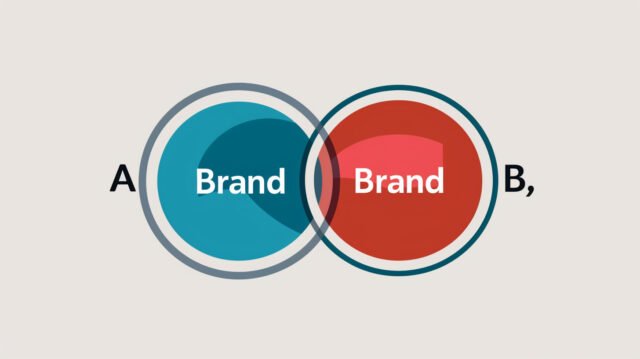
Finding the Perfect Brand Partners: Your Ultimate Guide
In the vibrant ecosystem of online business, brand partnerships are the secret weapon wielded by savvy marketers. It’s no longer just about building your own brand; it’s about leveraging the power of collaborations to amplify your reach, credibility, and ultimately, your bottom line. But, like any good partnership, it’s not about jumping into bed with the first brand that winks your way. Successful partnerships are born from strategic alignment, a synergy where both brands share a common audience and resonate with similar values.
This guide will equip you with the tools to not only identify but also secure partnerships that propel your brand forward. We’ll delve into the nitty-gritty of what makes a partnership tick, how to find the perfect match, and the secrets to nurturing a collaboration that’s mutually beneficial. Get ready to elevate your brand through the art of strategic alliances.
Why Strategic Partnerships Matter

Brand partnerships aren’t just a marketing buzzword; they’re a proven strategy for:
- Expanding Reach: Tap into new audiences who already trust and engage with your partner brand.
- Building Credibility: Align with established brands to enhance your reputation and authority.
- Increasing Sales: Cross-promotion and co-created products can drive revenue from both audiences.
- Gaining Valuable Insights: Learn from your partner’s expertise and experience.
Let’s be clear, not all partnerships are created equal. A mismatched partnership can do more harm than good, leading to a diluted brand identity and disengaged audiences. That’s why we’ll focus on the art of finding the right partners – those who complement your brand, amplify your message, and resonate with your audience.
What to Look for in a Partner: The 4 Pillars of Partnership Success

Finding the perfect brand partner is akin to finding a soulmate for your business. It’s about discovering a brand that not only shares your goals but also complements your strengths and fills your gaps. To navigate this exciting journey, let’s explore the four fundamental pillars that underpin successful partnerships:
1. Target Audience: Your Ideal Customer Matchmaker
Imagine trying to sell surfboards to a desert community – it’s a recipe for disaster. The same principle applies to brand partnerships. Your partner’s audience should mirror your ideal customer profile. If their followers aren’t interested in what you have to offer, the partnership is doomed from the start.
Key Questions to Ask:
- Who is your partner’s core audience?
- What are their demographics (age, gender, location)?
- What are their interests and pain points?
- How does their audience overlap with yours?
Tools like Google Analytics and social media analytics can provide valuable insights into your partner’s audience. Look for brands whose followers align with your target market.
2. Shared Values: The Glue That Binds
A partnership built on shared values is like a rock-solid foundation – it can withstand the storms of market fluctuations and changing trends. When your brands share similar values, ethics, and missions, your collaboration will resonate with both audiences, fostering a sense of authenticity and trust.
Key Questions to Ask:
- What are your partner’s core values?
- How do they communicate their values through their brand messaging and actions?
- Do their values align with yours?
- Can you envision a collaboration that reinforces both brands’ values?
A partnership with a brand that contradicts your values can damage your reputation and alienate your loyal customers. Choose wisely.
3. Reach: Expanding Your Digital Footprint
Partnering with a brand that boasts a massive following can significantly expand your reach. However, don’t be blinded by vanity metrics like follower count. True reach is about engagement – the level of interaction and influence a brand has with its audience.
Key Questions to Ask:
- What is your partner’s reach across various channels (website, social media, email)?
- How engaged is their audience?
- What is their average engagement rate (likes, comments, shares)?
- Can they drive meaningful traffic and conversions to your brand?
Don’t underestimate the power of micro-influencers or niche brands with highly engaged audiences. They might be the perfect partners to connect with your target market on a deeper level.
4. Partnership Opportunities: A Canvas for Collaboration
The possibilities for brand partnerships are endless, from co-created products and joint webinars to social media takeovers and cross-promotions. The key is to find a collaboration model that aligns with both brands’ goals and resources.
Key Questions to Ask:
- What are your partnership goals (e.g., increase brand awareness, drive sales, launch a new product)?
- What types of collaborations are you open to?
- What resources can you contribute to the partnership?
- What are your partner’s expectations?
Be creative and open-minded when exploring partnership opportunities. Don’t be afraid to think outside the box and propose unique collaborations that will excite both audiences.
How to Find the Right Partner: Your Brand Matchmaking Toolkit

Now that you understand the core pillars of a successful partnership, let’s dive into the nitty-gritty of finding your brand soulmate. Think of this as your matchmaking toolkit, designed to help you uncover those hidden gems that perfectly align with your brand’s vision and goals.
1. Research: Knowledge is Power
In the world of brand partnerships, knowledge truly is power. Before you even think about reaching out to potential partners, do your due diligence. Dive deep into their online presence, social media channels, and content. Look for clues that reveal their target audience, values, and overall brand personality.
- Pro Tip: Use tools like BuzzSumo or SEMrush to analyze their content performance and identify their top-performing channels. This will give you a glimpse into what resonates with their audience.
2. Networking: The Art of Connection
Networking isn’t just about exchanging business cards; it’s about building genuine relationships. Attend industry events, conferences, and webinars where you can rub shoulders with potential partners. Strike up conversations, share your brand story, and listen to theirs.
- Pro Tip: Follow up with promising connections after the event. Send a personalized email or LinkedIn message expressing your interest in their brand and exploring potential collaboration opportunities.
3. Social Media: Your Virtual Networking Hub
Social media is a goldmine for discovering potential partners. Follow brands that align with your target audience and values. Engage with their content, leave thoughtful comments, and share their posts. This will put you on their radar and open the door for future conversations.
- Pro Tip: Participate in relevant Twitter chats and Facebook groups to connect with like-minded brands and individuals. These platforms are often buzzing with partnership opportunities.
4. Content Marketing: Attract Partners with Compelling Content
Your content is a powerful magnet for attracting potential partners. Craft high-quality blog posts, articles, videos, and social media content that showcases your expertise and brand personality. When other brands see the value you bring to the table, they’ll be more likely to reach out and explore collaboration opportunities.
- Pro Tip: Share your content on social media and tag relevant brands. This will increase your visibility and attract the attention of potential partners.
5. Public Relations: Amplify Your Brand’s Voice
Public relations can be a game-changer in your quest for brand partnerships. Get featured in relevant publications, podcasts, and online media outlets. This will not only increase your brand awareness but also position you as a desirable partner.
- Pro Tip: Craft a compelling press release that highlights your brand’s unique value proposition and partnership potential. Distribute it to relevant media outlets and influencers.
Building a Successful Partnership: Nurturing the Seeds of Collaboration

Congratulations! You’ve found your brand soulmate. Now it’s time to nurture that connection and turn it into a thriving partnership. But remember, like any relationship, building a successful brand partnership requires effort, communication, and a willingness to adapt. Let’s delve into the key ingredients that foster a collaborative environment where both brands can flourish:
1. Communication: The Lifeline of Collaboration
Open, honest, and frequent communication is the lifeblood of any successful partnership. Set clear expectations from the get-go, discuss goals, responsibilities, timelines, and any potential roadblocks. Establish regular check-ins to ensure that both parties are on the same page and address any concerns promptly.
- Pro Tip: Use project management tools like Asana or Trello to track progress, share updates, and collaborate seamlessly. This will keep everyone in the loop and prevent miscommunications.
2. Goals: Your North Star
Before embarking on any collaborative venture, define clear and measurable goals for the partnership. What do you hope to achieve? Increased brand awareness? More sales? A successful product launch? Having well-defined goals will give your partnership direction and purpose.
- Pro Tip: Set SMART goals (Specific, Measurable, Achievable, Relevant, Time-bound) to ensure that you can track progress and evaluate the success of your partnership.
3. Measurement: Data-Driven Decision Making
Don’t leave the success of your partnership to chance. Implement a robust tracking and measurement system to monitor key metrics like website traffic, social media engagement, lead generation, and sales. This data will provide valuable insights into what’s working and what needs improvement.
- Pro Tip: Use UTM codes to track the performance of specific campaigns and channels. This will help you identify which tactics are driving the most results.
4. Flexibility: Embracing Change
The business landscape is constantly evolving, and your partnership should be agile enough to adapt to new challenges and opportunities. Be open to feedback, willing to experiment, and prepared to adjust your strategies as needed. A flexible approach will ensure that your partnership remains relevant and effective in the long run.
- Pro Tip: Schedule regular reviews of your partnership to assess progress, identify areas for improvement, and brainstorm new ideas. This will keep your collaboration fresh and exciting.
5. Authenticity: Staying True to Your Brand
While collaboration is key, don’t sacrifice your brand’s unique voice and identity in the process. Ensure that any co-created content or marketing campaigns align with your brand’s values and messaging. Authenticity is paramount in building trust with your audience.
- Pro Tip: Develop a clear brand guidelines document that outlines your brand’s voice, tone, visual identity, and messaging. Share this with your partner to ensure that all collaborative efforts are on-brand.
Conclusion: Your Brand Partnership Roadmap
As we’ve journeyed through the intricacies of brand partnerships, it’s clear that they’re not just a fleeting trend – they’re a powerful tool for sustainable growth. By aligning with brands that share your target audience and values, you unlock a world of possibilities, from expanding your reach and boosting credibility to driving sales and gaining valuable insights.
Remember, finding the right partner is just the beginning. Nurturing the relationship through open communication, clear goals, and data-driven decision-making is crucial for long-term success. Embrace flexibility, stay true to your brand’s authenticity, and don’t be afraid to experiment with different collaboration models.
But the true magic of brand partnerships lies in their ability to spark innovation and creativity. When two brands come together with a shared vision, they can create something truly extraordinary – a campaign, a product, or an experience that resonates deeply with their audiences and leaves a lasting impact.
So, are you ready to embark on your brand partnership journey? Armed with this comprehensive guide, you have the knowledge and tools to identify the right partners, build strong relationships, and unleash the full potential of your brand.
Key Takeaways:
- Brand partnerships are a strategic investment, not a quick fix.
- Prioritize alignment in target audience, values, and partnership goals.
- Research, networking, and content marketing are your allies in finding the perfect match.
- Open communication, clear goals, and data-driven decision-making are the pillars of a successful collaboration.
- Embrace flexibility, authenticity, and creativity to create partnerships that truly shine.
- Now, go forth and forge those powerful alliances that will propel your brand to new heights!
FAQs
Beyond audience demographics, what psychographic factors should I consider when evaluating a potential brand partner’s audience?
While demographics are essential, delve deeper into psychographics: values, interests, lifestyle choices, and pain points. Do your audiences share similar aspirations, concerns, or humor? A strong psychographic alignment can lead to more meaningful and impactful collaborations.
How can I gauge a potential partner’s brand authenticity before committing to a partnership?
Look beyond their marketing materials and delve into their actions. Do they actively support the causes they claim to champion? Are their employees engaged and passionate about the brand? Look for consistency between their words and actions to gauge their authenticity.
What are some red flags to watch out for during partnership negotiations that might signal potential issues down the line?
Be wary of partners who are inflexible, unresponsive, or unwilling to compromise. If they exhibit a lack of transparency or make promises they can’t keep, it could indicate a lack of commitment or a potential for conflict in the future.
How can I measure the success of a brand partnership beyond just sales and website traffic?
Consider broader metrics like brand sentiment, social media mentions, and earned media coverage. These qualitative measures can provide valuable insights into how the partnership is impacting your brand’s reputation and perception among your target audience.
What are some creative ways to activate a brand partnership beyond traditional co-marketing campaigns?
Think outside the box! Consider hosting joint events, creating a co-branded product line, or launching a unique social media challenge. The more creative and engaging your activation, the more likely it is to resonate with your audience and generate buzz.
How can I leverage my existing network to identify potential brand partners?
Tap into your network of industry contacts, colleagues, and even customers for recommendations. Attend industry events and conferences to meet new people and explore potential synergies. Don’t underestimate the power of word-of-mouth referrals.
What are the legal and ethical considerations I should be aware of when entering into a brand partnership?
Answer: Ensure you have a clear understanding of intellectual property rights, confidentiality agreements, and any potential conflicts of interest. It’s crucial to have a written agreement in place that outlines the terms and conditions of the partnership to protect both parties.
How can I ensure that a brand partnership doesn’t overshadow my own brand’s identity?
Clearly define your brand’s unique value proposition and messaging before entering into a partnership. Maintain a strong brand voice throughout the collaboration, and ensure that any co-created content aligns with your brand’s overall identity.
What are some common mistakes to avoid when building a brand partnership?
Avoid rushing into a partnership without proper due diligence. Don’t overpromise and underdeliver. Communicate openly and honestly with your partner. And most importantly, don’t let the partnership overshadow your own brand’s identity and goals.
What are some emerging trends in brand partnerships that I should be aware of?
Keep an eye on the rise of purpose-driven partnerships, the growing importance of authenticity and transparency, the convergence of technology and creativity, the power of data and analytics, and the emergence of micro-communities. By staying ahead of the curve, you can identify new opportunities and stay relevant in the ever-evolving world of brand collaborations.

Hey there! Liam here. I’m all about connecting us with awesome partners so we can bring you even more fantastic deals. When I’m not building relationships, you’ll probably find me cheering on my favorite soccer team or checking out the latest live music spot.